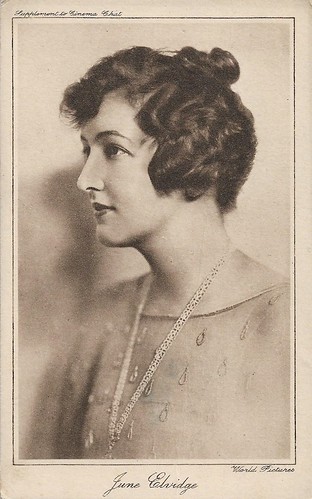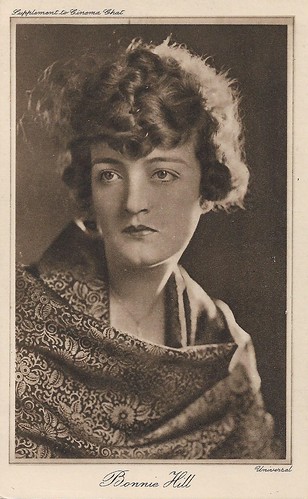
British postcard by Cinema Chat, Series 3. Photo: Garrick.
Ena Beaumont (1892-1986) was a British silent screen actress. She was known for such films as The Girl from Downing Street (1918), The Greater Love (1919), and Patricia Brent, Spinster (1919).

British postcard by Cinema Chat, Series 3. Photo: Fox.
American screen actress Gladys Brockwell (1894-1929) made her screen debut in Philadelphia for the Lubin Company in 1913, later working with D.W. Griffith. She joined the Fox Studios and was one of the busiest actresses in town and later easily made the transition to sound films. Among her 117 films are Frank Lloyd's Oliver Twist (1922) with Jackie Coogan, Wallace Worsley's The Hunchback of the Notre Dame (1923), with Lon Chaney, and Frank Borzage's Seventh Heaven (1927) with Janet Gaynor.

British postcard by Cinema Chat, Series 4. Photo: Fox.
American actress Jewel Carmen (1897-1984) made her film debut in Daphne and the Pirate (1916) when she was 19 years old. After Confession (1918) she left the film industry for three years before returning in Nobody (1921). Her final film was Roland West's thriller The Bat (1926) which was one of the inspirations for Bob Kane's 'Batman'.

British postcard by Cinema Chat, Series 2. Photo: World Pictures.
June Elvidge (1893-1965) was an American screen actress of the silent era, who specialised in playing vamps. She was known for such silent films as The Power and the Glory (1918), The Social Pirate (1919), and Beauty's Worth (1922).

British postcard by Cinema Chat, Series 3. Photo: Apeda / Famous Players.
Pauline Frederick (1883-1938) was an American theatre and film actress, who made a name for herself in the theatre and had already passed thirty when she became successful in Hollywood. In the period of silent pictures, she was one of the most powerful actresses in the film industry.

British postcard by Cinema Chat, Series 2. Photo: Vitagraph.
Corinne Griffith (1894–1979) was an American film actress, producer, and author. Dubbed 'The Orchid Lady of the Screen', she was one of the most popular film actresses of the 1920s and widely considered the most beautiful actress of the silent screen. While she started out at Vitagraph in 1916, she became a very popular actress at First National Pictures. She was nominated for the Academy Award for Best Actress for her performance in Frank Lloyd's The Divine Lady (1929), an American Vitaphone sound film with a synchronised musical score, sound effects, and some synchronised singing, but no spoken dialogue. When sound film set in, Griffith stopped acting and became a successful writer and businesswoman.

British postcard by Cinema Chat, Series 1. Photo: Selznick / Bradley Studios.
American screen actress Elaine Hammerstein (1897-1948) was the granddaughter of the reputed actor Oscar Hammerstein, and the daughter of producer Arthur Hammerstein, famous for the operettas 'Naughty Marietta' (1910) and 'Rose-Marie' (1924). Elaine was first active on Broadway and debuted on-screen at World Film in the Wilkie Collins adaptation The Moonstone (1915). After a few films with Harry Rapf in the late 1910s, she shifted to Selznick in 1918, where she remained for several years. In 1924 she shifted to Columbia Pictures, where she stopped her film career in 1926 when she married.

British postcard by Cinema Chat, Series 2. Photo: Universal.
Beautiful American screen actress Bonnie Hill (1891-1971) began working as a model in the early 1910s. Bonnie arrived in Hollywood in 1919. She played in Billions (1920), starring Alla Nazimova, and as the pretty neighbour in Buster Keaton's The Frozen North (1922). Bonnie was last seen on screen as Mrs. Wyman in The Love Gamble (1925), starring Lillian Rich.

British postcard by Cinema Chat, Series 2. Photo: Central.
This is not Beulah Livingstone (1886-1975), who was a publicist in the theatrical and motion picture industries. It is American film actress and producer Norma Talmadge (1894-1957). A major box-office draw for more than a decade, her career reached a peak in the early 1920s, when she ranked among the most popular idols of the American screen.

British postcard by Cinema Chat, Series 2. Photo: National / Goldwyn.
American screen actress Mae Marsh (1894-1968) began at the Biograph Studios with small roles in short films. She made her debut in Ramona (1910) featuring Mary Pickford. Director D.W. Griffith, fed up with Pickford's behaviour, used Marsh regularly in films for which Pickford was potentially eligible. She had roles in Griffith's features Judith of Bethulia (1914), The Birth of a Nation (1915), and Intolerance: Love's Struggle Throughout the Ages (1916). After this, she signed a contract with Samuel Goldwyn. In the 1920s she went to Britain. Her last film with Griffith was The White Rose (1923) with Ivor Novello. In 1925, she stopped acting in silent films. Marsh returned to the screen after the emergence of the sound film and made brief appearances in such classics as Drums Along the Mohawk (1939), My Darling Clementine (1946), The Searchers (1956), and Cheyenne Autumn (1964).

British postcard by Cinema Chat, Series 2. Photo: Fox.
American silent screen actress Shirley Mason (1900-1979) was the youngest of three acting sisters: the others were Edna Flugrath and Viola Dana. Her second film was Vanity Fair (1915). Her breakthrough was the title role in The Awakening of Ruth (1917). By the time the 1920s rolled around she was making fewer films, but taking on more substantial parts in films such as the Fox productions Flame of Youth (1920), Love's Harvest (1920), and Very Truly Yours (1922). Her final film was The Flying Marine (1929), after which she retired.

British postcard by Cinema Chat, Series 2. Photo: F.B.O. (Film Booking Office).
Evelyn Nesbit a.k.a. Evelyn Thaw was an American artists' model and chorus girl on Broadway, who was at the heart of 'the Crime of the Century'. In 1906, her abusive husband, Pittsburgh million-heir Harry Thaw, murdered 52-year old architect and socialite Stanford White, who had taken advantage of a sixteen-year-old Evelyn and subsequently become her lover. From 1914 Nesbit started to act in films, initially under her husband's name Thaw, her first film being the Lubin production Threads of Destiny (1914). Ironically, she often played women of dubious reputation.

British postcard by Cinema Chat, Series 2. Photo: Lumiere / Supreme Pictures.
This is not Peggy Shannon (1907-1941) but American actress Peggy Shanor (1896–1935). Shanor appeared in such silent films as The Queen of Hearts (1918), The Lurking Peril (1919), and The Prodigal Judge (1922).

British postcard by Cinema Chat, Series 4. Photo: Fox.
Madlaine Traverse (1875-1964) was an American stage and screen actress from Cleveland, Ohio. In the course of her career, she was alternately billed as "Madaline Traverse", "Madeline Traverse" and "Madeline Travers".

British postcard in the Cinema Chat series, Series 1. Photo: Evans / Pathé.
Fannie Ward, a.k.a. Fanny Ward (1872–1952) was an American actress of stage and screen, known for The Cheat (1915), a sexually- and racially-charged silent film directed by Cecil B. DeMille. In the late 1910s, she did a series of films for Astra Films, released by Pathé Exchange.
Sources: Our Cinema Postcards and Marlene Pilaete. See also our Flickr album.
No comments:
Post a Comment